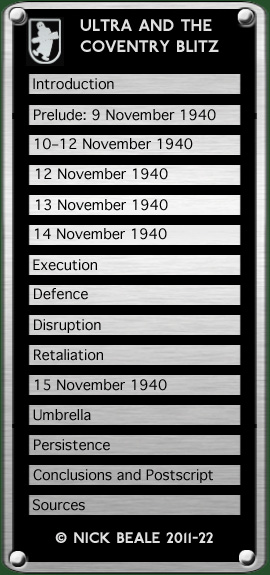|
Leutnant Probst was interrogated but at first he would only talk about the circumstances of his crash, refusing even to name his unit (apparent from the markings on his wrecked Heinkel). He was put in with a cellmate to whom he talked more freely, apparently not suspecting that this individual was an “S.P.” (stool pigeon) planted by Air Intelligence’s K Section or A.I.1(k). When captured, Probst’s morale had been assessed as good, perhaps because, as he told his new “comrade”, he believed Britain was on the brink of collapse with rioters attacking Buckingham Palace. Reichsmarschall Göring, he claimed, had decided the time had come for a decisive material and psychological blow, a “colossal raid” on Coventry and Birmingham during the next full-moon period, 15–20 November. “Every bomber in the Luftwaffe” would take part, using all the available Knickebein navigational beams and the main targets would be working-class housing, in the hope of precipitating a revolt. A.I.1(k)’s Squadron Leader Denys Felkin typed up Probst’s revelations in a note to the Director of Intelligence, dated 12 November and saying “this came after S/L Humphrey’s visit this afternoon.”
Felkin warned that Probst’s statements should be treated with reserve: he was an untried source and Humphrey had that afternoon mentioned “pretty definite information” that the gigantic attack was to be on London and the surrounding area. Felkin did not specifically address how it was that a junior officer flying over enemy territory knew so much about an operation due six days or more after his final take-off—if he was not shooting a line (as we now know he was not) then the Luftwaffe’s operational security was dreadfully lax. At any rate, Air Vice-Marshal D.F. Stevenson, the Director of Home Operations, decided that the information was “good enough to prepare a plan” which could be implemented once the “D3R” tuning signal—in effect announcing that “Moonlight Sonata” was on for that night—was heard. This response would take in radio countermeasures (RCM) against the beams and enemy beacons; concentration of the RAF’s night fighter force around the likely target and lines of approach; bombers and intruders harassing 30 enemy aerodromes; alerting Anti-Aircraft Command and authorising extra ammunition expenditure; and Bomber Command’s heavies raiding “a similarly important area in Germany as hard as we can.” The plan aimed “to pour cold water on the Moonlight Sonata” and so “Cold Water” it became. Stevenson was however a realist: … we should remember that if the maximum scale of night attack is concentrated on a place like London or Birmingham, no matter what we do, serious superficial damage will be done and high casualties caused—quite apart from any key point that might be hit. This is a powerful answer to those who have suggested over the years that Coventry was somehow “sacrificed” to protect Ultra. There was another problem in mounting any form of defence, as yet the British did not know what the targets were. They had a signal mentioning target areas 1–4 and they had a prisoner of untested reliability talking of Birmingham and Coventry. A third source was a captured map, also from Fliegerkorps I, marked with the figures 1, 2, 3 and 4. Wing Commander Grant of A.I.1(w) interpreted these as:
These areas were evidently approximations since Bletchley three days later would describe them somewhat differently. Nevertheless, the apparent consistency between the signal and the map would weigh heavily in the conclusions reached by Deputy Chief of the Air Staff, AVM William Sholto Douglas and his advisors.
continued on next page …
|
|||||||||||||

